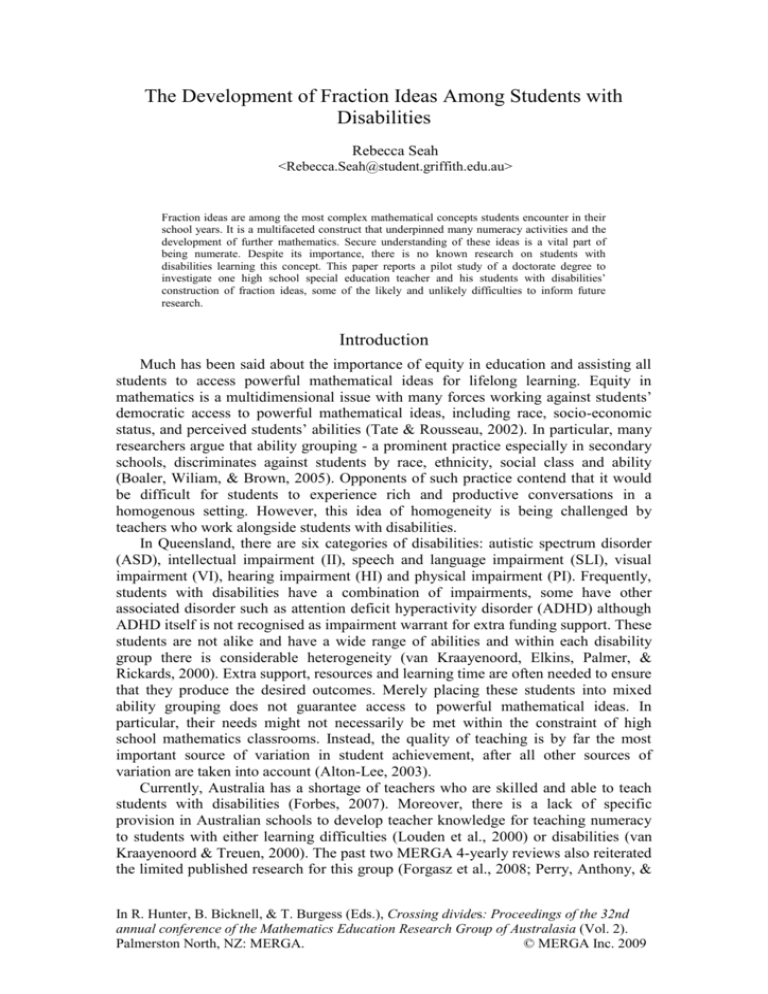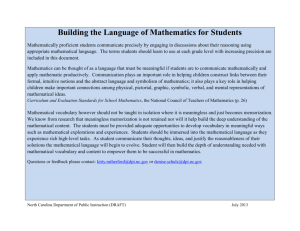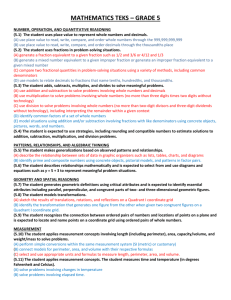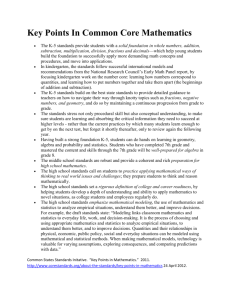
The Development of Fraction Ideas Among Students with
Disabilities
Rebecca Seah
<Rebecca.Seah@student.griffith.edu.au>
Fraction ideas are among the most complex mathematical concepts students encounter in their
school years. It is a multifaceted construct that underpinned many numeracy activities and the
development of further mathematics. Secure understanding of these ideas is a vital part of
being numerate. Despite its importance, there is no known research on students with
disabilities learning this concept. This paper reports a pilot study of a doctorate degree to
investigate one high school special education teacher and his students with disabilities’
construction of fraction ideas, some of the likely and unlikely difficulties to inform future
research.
Introduction
Much has been said about the importance of equity in education and assisting all
students to access powerful mathematical ideas for lifelong learning. Equity in
mathematics is a multidimensional issue with many forces working against students’
democratic access to powerful mathematical ideas, including race, socio-economic
status, and perceived students’ abilities (Tate & Rousseau, 2002). In particular, many
researchers argue that ability grouping - a prominent practice especially in secondary
schools, discriminates against students by race, ethnicity, social class and ability
(Boaler, Wiliam, & Brown, 2005). Opponents of such practice contend that it would
be difficult for students to experience rich and productive conversations in a
homogenous setting. However, this idea of homogeneity is being challenged by
teachers who work alongside students with disabilities.
In Queensland, there are six categories of disabilities: autistic spectrum disorder
(ASD), intellectual impairment (II), speech and language impairment (SLI), visual
impairment (VI), hearing impairment (HI) and physical impairment (PI). Frequently,
students with disabilities have a combination of impairments, some have other
associated disorder such as attention deficit hyperactivity disorder (ADHD) although
ADHD itself is not recognised as impairment warrant for extra funding support. These
students are not alike and have a wide range of abilities and within each disability
group there is considerable heterogeneity (van Kraayenoord, Elkins, Palmer, &
Rickards, 2000). Extra support, resources and learning time are often needed to ensure
that they produce the desired outcomes. Merely placing these students into mixed
ability grouping does not guarantee access to powerful mathematical ideas. In
particular, their needs might not necessarily be met within the constraint of high
school mathematics classrooms. Instead, the quality of teaching is by far the most
important source of variation in student achievement, after all other sources of
variation are taken into account (Alton-Lee, 2003).
Currently, Australia has a shortage of teachers who are skilled and able to teach
students with disabilities (Forbes, 2007). Moreover, there is a lack of specific
provision in Australian schools to develop teacher knowledge for teaching numeracy
to students with either learning difficulties (Louden et al., 2000) or disabilities (van
Kraayenoord & Treuen, 2000). The past two MERGA 4-yearly reviews also reiterated
the limited published research for this group (Forgasz et al., 2008; Perry, Anthony, &
In R. Hunter, B. Bicknell, & T. Burgess (Eds.), Crossing divides: Proceedings of the 32nd
annual conference of the Mathematics Education Research Group of Australasia (Vol. 2).
Palmerston North, NZ: MERGA.
© MERGA Inc. 2009
Diezmann, 2004). The sparsity and often dated research means that we know very
little about these students’ mathematics learning. Internationally, the amount of
research devoted to mathematics instruction for students with disabilities, especially
those with mental retardation, has remained relatively constant over the past 25 years
with an average of 16 studies spanning a 10-year period (Butler, Miller, Lee, &
Pierce, 2001). In particular, many studies place substantial emphasis on using
experimental design to investigate the effect of various instructions such as direct
instruction, drill and practice and time delay on basic skill training and computation.
This exclusive focus on rules and algorithm has unavoidably prevented many students
with disabilities from experiencing rich mathematical ideas.
There are three assumptions that may have produced such insipid and often
predictable research. First is the stereotypical belief that these students are incapable
of devising cognitive strategies and engaging in mathematical problem solving.
Secondly, the belief that mathematics is sequential suggests a need to fully teach each
concept in succession. Third is the lack of collaboration and communication among
special education and mathematics researchers and classroom teachers. Consequently,
valuable resources are wasted in conducting research intervention that produces
minimum influence on classroom practice. Schooling for most students, those with
disabilities in particular, “is an endless sequence of memorising and forgetting facts
and procedures that make little sense to them (Battista, 1999, p. 426). Battista warned
that such teaching would seriously stunt the growth of students’ mathematical
reasoning and problem-solving skills. Indeed, “in the information age and the web
era, obtaining facts is no longer the problem; analysing and making sense of them is”
(Battista, 1999, p. 428).
Accordingly, numeracy development for students with disabilities should be given
greater emphasis when making curriculum decisions. Numeracy is the ability to use
mathematics effectively to meet the general demands of life at home, in paid work,
and for participation in community and civic life” (Australian Association of
Mathematics Teachers (AAMT), 1997, p. 15). It is contextualised and requires
flexible thinking and using of mathematics to solve problems. Since much of the daily
demands in life involves proportional reasoning, such as perusing a recipe, home
loans, interest rates, phone deals and other civic related activity, it follows that
students with disabilities must be taught how to handle rational number as well.
Rational numbers is considered to be among the most difficult topics to learn in
foundational mathematics (McGee, Kervin, & Chinnappan, 2006). The multifaceted
nature of the concept means that careful attention must be given to develop the
meanings of different rational number representations and the connections among
them. Despite the voluminous amount of literature produced, how students become
proficient with rational numbers is not as well understood as with whole numbers
(Kilpatrick, Swafford, & Findell, 2001). In particular, earlier experiences often cause
serious conflicts when learning rational numbers, such that 1/9 is considered as bigger
than 1/8 and 3/5 + 2/4 = 5/9. To date, there is no known research study that looks at how
students with disabilities learn rational number. Consequently, this preliminary study
seeks to survey students with disabilities’ initial fraction ideas and investigate the
effectiveness of using instructional games to help students connect different
representations to the appropriate fractions. The aim is to investigate one special
education teacher and his class’s construction of fraction ideas and use the knowledge
gained to inform future investigation.
484
Method
This paper takes the position that sustained transformation of practice occurs
when research is conducted with teacher and students as they construct mathematical
knowledge together. It uses the principles of participatory action research
(McTaggart, 1997) to conduct a series of flexible cycles of action and reflection
between the researcher and the teacher as they examine the effect of each learning
task on students’ understanding of initial fraction ideas. In particular, it focuses on
students’ understanding of equal and unequal parts, number lines and partitioning.
The strategies and instructional games presented here draw on the work of George
Booker (Booker, 2000; Booker et al, 2004). The initial introduction focuses on
helping students construct mental representations of fraction ideas and the language
associated with them (see figure 1) through games and hands on activities involving
fraction models and number lines.
Materials/Models
Fraction Ideas
Language
Symbols
Figure 2: Booker’s connected sequence of mathematical development (Booker et al., 2004)
Developing secure understanding of the part/whole relationship is crucial because
struggling learners’ knowledge about fractions tend to be rigid and fragmented,
focusing solely on “rules” and procedures rather than knowing why and finding
creative ways of solving problems. Consequently, multiple representations are used to
link concrete materials and models with appropriate corresponding ordinal names to
investigate whether students are able to comprehend fraction ideas.
Participants and Data Collection
This study is conducted in a Brisbane high school situated in a low socioeconomic area. The school’s Special Education Program (SEP) runs a modified
program for the four main key learning areas (English/Math/SOSE/Science) for Year
8 to Year 10 students with disabilities. The special education teacher Terry and his
Year 8 class were selected to participate in this action research. Despite the lack of
formal training in special education and mathematics, Terry has had extensive
experience working with students with disabilities and other educationally
disadvantaged students. He is enthusiastic and views rational numbers as an important
construct his students need for lifelong learning. His class consists of Tim who has
ASD, Jack who has learning difficulties, May, and Cassie have speech and language
impairment and five students, Pete, Kerry, Sale, Jacob and Ashley, with intellectual
impairment. An initial interview was carried out with the whole class by the
researcher to identify students’ level of understanding in relation to fraction ideas.
Information collected is then used to initiate the cycle of planning, teaching, and
evaluating process (Kemmis & Wilkinson, 1998). Instructions were modified and
presented repeatedly to ensure that each student understand the task demand. Students
were presented with a series of questions such as:
1. Have you heard of the word “fractions”?
485
2. Can you draw or write something about “fractions” and show me how it looks
like?
Students were then given a task sheet and asked to shade each circle according to
the instructed parts given by the researcher. The questions were:
1. Can you cut the circle into half?
2. Can you cut the circle into three equal parts?
3. Can you cut the circle into four equal parts? Can you then shade three out of
the four equal parts?
4. Can you cut the circle into five equal parts? Can you then shade two out of the
five equal parts?
5. Can you cut the circle into six equal parts? Can you then shade three out of the
six equal parts?
6. Can you cut the circle into eight equal parts? Can you then shade all the eight
equal parts?
This is followed by a series of teaching activities designed to develop students’
understanding of initial fraction ideas. The intervention took place three times per
week during their numeracy block. Each session lasted between 30 to 40 minutes
depending on the task demand and students’ responsiveness. Weekly discussion
between the researcher and Terry involves evaluation of previous lessons, assessment
on students’ response to task, and planning for next stage of students’ learning. The
following reports the result of one term’s intervention.
Results and Discussion
Seven students were present on the day of the baseline interview. Unfortunately,
Tim was very uncooperative on that day and refused to participate. It could be that the
change of routine has upset his need for consistency and thus he was unable to deal
with the change. Students had great difficulty drawing or writing something to
represent fractions. Jack was the only one who wrote: ½ + ¾ =. When asked how he
would say what he wrote, he replied “one two plus three four equal. Since Jack has
learning difficulty, it can be assumed that he might have came across this form of
fraction ideas in regular class. Nevertheless, his fragmented knowledge is revealed
through his inability to address the fractions appropriately.
The results for the second task were presented below:
Table 1.
Number of Correct Response N=7
½
6
1
/3
¾
0
4
2
/5
0
3
/6
4
8
/8
4
On the whole, these students’ knowledge about fraction ideas was sketchy and
restricted to their daily experience. Half is a concept that all of them would have
encountered in their daily life so it was not difficult to perform. 1 third and 2 fifths
present great challenge for these students, as none was able to cut it into equal parts.
In fact, two students consistently failed to segment the parts equally. Four students
have reasonable success with 3 fourth and 8 eights. The result for 3 sixths was
486
inconclusive as none of them were able to segment the parts equally but all four
students managed to shade half of the circle. It could be that a lack of spatial
awareness has prevented students from segmenting the parts equally.
The intervention took place in Term 4 of year 8. Many of these students do not
have much prior knowledge about fraction ideas. They also do not have experience
working in groups and can give up easily or disrupt the class as soon as the task
becomes too hard. A list of instructional games and concrete materials such as
fractions pieces were used to build students’ interest and develop students’
understanding of equal parts. The aim is to link the language and symbol with the
appropriate representations (see figure 2). Kroesbergen and Van Luit (2003) assert
that leaving students especially those with learning difficulties and disabilities, to
discover hidden knowledge in the resource materials alone is unlike to succeed. In
each lesson, explicit instructions were given to help students recognise, order and
compare fractions. Instructions were repeated and rephrased when necessary to make
sure that students comprehend the task demand.
0
1
2
2
2 thirds
/3
Figure 2: Instructions to link representations and language with the appropriate symbol.
Both the Colour a Fraction Game (Booker, 2000) and identifying “Equal and
Unequal Parts” were met with reasonable success although explicit instructions had
to be given to ensure that students can identify the difference between each
representation and get used to the language used to describe each fraction model.
Students were more confident in dealing with fraction models than with number lines.
It is possible that these students are more familiar with the idea of fraction models
than the concept of fraction as a point on a number line. A number of researchers have
also noted how knowledge of whole number operations can interfere with students’
development of fraction ideas (Behr & Post, 1988; Pearn & Stephens, 2007). Indeed,
these students were getting quicker at counting spaces on the number line to obtain
the correct answer. However, a shift of thinking based on a counting algorithm is
needed if their knowledge about fraction ideas were to progress further (Behr & Post,
1988). Three students continue to face difficulty in matching fraction models or
number line with the appropriate words, due largely to their lower reading ability.
The paper folding activity was met with much frustration. One explanation could
be that many of them do not have well developed fine motor control and thus has
unavoidable affected their performance on the task. Consequently, many were
annoyed by the crumpled strip of paper. The other reason could also due to a lack of
spatial awareness. However, we not yet been able to design a task to check on this
development.
The last activity required students to fold fraction circles and strips of papers into
half and quarters and then name which of the two is larger. Although students were
able to carry out the task with reasonable success, none of them could correctly
identify 1/7 as smaller than ¼ when the question was given straight after the folding
487
activity. It appears that how a task is presented and the timing of its introduction can
significantly impact students’ construction of mathematical ideas. In this case, the
comparing task was introduced too quickly without knowing whether students had
developed an understanding of the part-whole relationship. Indeed, further
investigation is needed to consider this aspect of the learning process.
Discussion with Terry revealed a greater insight into the difficulty teachers
encounter and a need for professional development to focus on developing teachers’
mathematical content knowledge, pedagogical knowledge, knowledge about their
students’ learning and the relationships among them. He noted that the weekly
discussions with the researcher alerted him to pay attention to how individual students
construct mathematical ideas and assisted in his planning process. He was able to
target a specific area of difficulties and work out a strategy to help individuals
construct their own knowledge. The structured, sequential step-by-step instructions
were very beneficial for his students as it helps to draw their attention to each
component without feeling overwhelmed by the amount of information at hand. The
variety of visual and hands on activities created high interest and students were very
engaged. Since the starting of this project, his students are beginning to enjoy working
in groups whereas previously they were intolerable towards each other. This is
particularly significant for Tim who struggles with group work and changes of
routine. Terry highlighted that the language of mathematics played an important part
in his students’ understanding of fraction ideas. He asserted that the process has
helped him learn to give instruction that is concise and straight to the point. He
pointed out that the language used in the past (e.g. 1 over 4 rather than 1 out of 4)
continues to influence the way some students operate. Nevertheless, he believes that
in time to come this problem will be overcome so long as students continue to be
immersed in the rich and appropriate mathematical conversations. He was quite
excited by the fact that one of his students was able to link the vinculum to the
dividing symbol (÷).
Moreover, Terry commented that not knowing the right starting point to teach is
the biggest frustration he faced. He lamented that:
I look through all the resource books I can find but they don’t tell you if it’s for which level. I’ve
no way of knowing if the activity is too hard or too easy for my students and I don’t know what to
do after that. The pictures in the textbook are two dimensions and these students need concrete
materials that they can touch and play with.
The weekly discussions have helped Terry better understand the difficulties
students faced, broaden his teaching repertoire and empowered him to construct
knowledge of his own. He repeatedly emphasised the need for activities that provide
sequential step-by-step instructions so that teachers are better able to handle
uncertainty in class. He maintained that this series of developing students’ initial
fraction ideas has help to build the basis where he could carry his students through.
“Whenever they are stuck, we always go back to the basic and try again. For these
students this is important”.
Conclusion and Implications
This study set out to survey students with disabilities’ knowledge about fraction
ideas and the type of instructions that best promote learning. The data collected have
help to construct a series of questions for future research. Firstly, the idea of explicit
instruction based on constructivism is not well understood. Within the special
education literature, explicit instruction often denotes direct instruction and drill and
488
practice. Further research is needed to assist teachers in framing their instructions to
assist students to think mathematically.
Relating to the issue of instruction is the need for a structured program to help
teachers of non-mathematics teach rational numbers. Currently, there is no known
program that teaches students with disabilities to learn fractions. Timing and pacing in
instructional delivery certainly play a huge part in the success of students’ learning.
Moreover, we do not know to what extent the impact of a disability has on a student’s
construction of mathematical ideas. It is clear that more research is needed in the area
of professional development to link these issues together to improve current practice.
Instructional games and concrete materials were found to be very effective in
developing students’ engagement and initial fraction ideas. Unfortunately, the
timeframe for this study was too short to truly evaluate each task and how they could
be linked to assist students’ understanding. Consequently, this may have affected
students’ performance.
The results from the initial baseline interview revealed that many students with
disabilities have very limited understanding of what fraction is and how that relates to
their daily activity. If they are to become numerate, they must be given the chance to
experience different mathematical ideas. Only by doing so could the true meaning of
equity in education be realised.
References
Alton-Lee, A. (2003). Quality teaching for diverse students in schooling: Best evidence synthesis.
Retrieved
September
13,
2006.
from
http://www.minedu.govt.nz/index.cfmlayout=document&documentid=8646&indexid=6088&inde
xparentid=1000.
Australian Association of Mathematics Teachers (AAMT). (1997). Numeracy = Everyone's business,
Report of the Numeracy Education Strategy Development Conference. Adelaide: Author.
Battista, M. T. (1999). The mathematical miseducation of America's youth ignoring research and
scientific study in education. Phi Delta Kappan, 80(6), 424-433.
Behr, M. J., & Post, T. R. (1988). Teaching rational number and decimal concepts. In T. R. Post (Ed.),
Teaching Mathematics in Grades K-8 (pp. 201-248). Boston, MA: Allyn and Bacon.
Boaler, J., Wiliam, D., & Brown, M. (2005). Students' experiences of ability grouping: disaffection,
polarisation and the construction of failure. In M. Nind, J. Rix, S. Kieron & K. Simmons (Eds.),
Curriculum and pedagogy in inclusive education: Values into practice (pp. 41-55). London:
RoutledgeFalmer.
Booker, G. (2000). The maths game: Using instructional games to teach mathematics. Wellington:
New Zealand Council for Educational Research.
Booker, G., Bond, D., Sparrow, L., & Swan, P. (2004). Teaching primary mathematics (3rd ed.).
Australia: Pearson Prentice Hall.
Butler, F. M., Miller, S. P., Lee, K.-h., & Pierce, T., G. (2001). Teaching mathematics to students with
mild-to-moderate mental retardation: A review of the literature. Mental Retardation, 39(1), 20-31.
Forbes, F. (2007). Towards inclusion: An Australian perspective. Support for Learning, 22(2), 66-71.
Forgasz, H., Barkatsas, A., Bishop, A., Clarke, B., Keast, S., Seah, W. T., et al. (Eds.). (2008).
Research in mathematics education in Australasia 2004-2007. Rotterdam, The Netherlands:
Sense Publishers.
Kemmis, S., & Wilkinson, M. (1998). Participatory action research and the study of practice. In B.
Atweh, S. Kemmis & P. Weeks (Eds.), Action research in practice: partnerships for social justice
in education (pp. 21-36). London: Routledge.
Kilpatrick, J., Swafford, J., & Findell, B. (2001). Adding it up: Helping children learn mathematics.
Washington, DC: National Academy Press.
Kroesbergen, E. H., & Van Luit, J. E. H. (2003). Mathematics interventions for children with special
educational needs: A meta-analysis. Remedial and Special Education, 24(2), 97.
489
Louden, W., Chan, L. K. S., Elkins, J., Greaves, D., House, H., Milton, M., et al. (2000). Mapping the
territory, primary students with learning difficulties: Literacy and numeracy, (Vol.1, 2, & 3).
Canberra, ACT: Department of Education, Training and Youth Affairs.
McGee, L., Kervin, L., & Chinnappan, M. (2006). Emerging issues in the investigation of the construct
of partitive quotient. In P. Grootenboer, R. Zevenbergen & M. Chinnappan (Eds.), Identities,
Cultures and Learning Spaces. Proceedings of the 29th annual conference of the Mathematics
Education Research Group of Australasia (Vol. 2, pp. 360-367). Adelaide: MERGA.
McTaggart, R. (Ed.). (1997). Participatory action research: International contexts and consequences.
Albany, NY: State University of New York Press.
Pearn, C., & Stephens, M. (2007). Whole number knowledge and number lines help to develop fraction
concepts. In J. Watson & K. Beswick (Eds.), Mathematics: Essential Research, Essential
Practice. Proceedings of the 30th annual conference of the Mathematics Education Research
Group of Australasia (Vol. 2, pp. 601-610). Tasmania: MERGA.
Perry, B., Anthony, G., & Diezmann, C. (Eds.). (2004). Research in mathematics education in
Australasia 2000-2003. Flaxton, QLD: Post Pressed.
Tate, W., & Rousseau, C. (2002). Access and opportunity: The political and social context. In L.
English, M. G. B. Bussi, G. Jones, R. Lesh & D. Tirosh (Eds.), Handbook of international
reserach in mathematics education. Mahwah, New Jersey: Lawrence Erlbaum Associates.
van Kraayenoord, C., Elkins, J., Palmer, C., & Rickards, F. W. (2000). Literacy, numeracy and students
with disabilities. Canberra, Australia: Department of Education, Training and Youth Affairs.
van Kraayenoord, C., & Treuen, M. (2000). Provision of professional development in literacy and
numeracy for students with learning difficulties and disabilities. In W. Louden, L. K. S. Chan, J.
Elkins, D. Greaves, H. House, M. Milton, S. Nichols, J. Rivalland, M. Rohl & C. van
Kraayenoord (Eds.), Mapping the territory—primary students with learning difficulties: Literacy
and Numeracy. Vol 2: Analysis (pp. 83-123). Canberra, Australia: Department of Education,
Training and Youth Affairs (DETYA).
490








